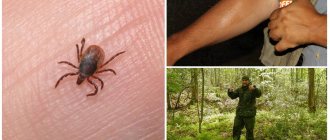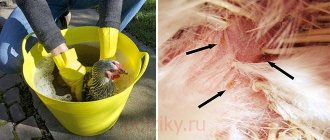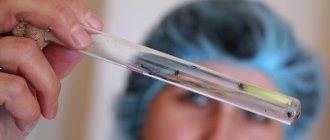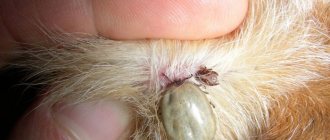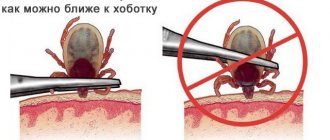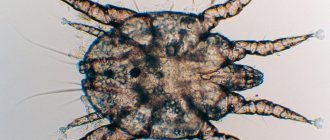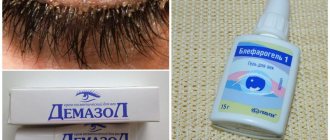Tick-borne encephalitis
Tick bite
Borreliosis
15607 November 11
IMPORTANT!
The information in this section cannot be used for self-diagnosis and self-treatment.
In case of pain or other exacerbation of the disease, diagnostic tests should be prescribed only by the attending physician. To make a diagnosis and properly prescribe treatment, you should contact your doctor. We remind you that independent interpretation of the results is unacceptable; the information below is for reference only.
Ixodid tick research: indications for use, rules for preparing for the test, interpretation of the results and normal indicators.
Detailed description of the study
Infections carried by ixodid ticks are dangerous, and their symptoms are similar to each other. Some ticks can carry pathogens of several diseases at once, which complicates the course of the disease and complicates diagnosis.
Tick-borne encephalitis is a viral infection that affects the tissues of the brain and spinal cord and/or their membranes. You can get sick when ixodid ticks are active: in spring and summer. On average, 6 out of 10 ticks carry the virus across the country, but due to the uneven distribution of these insects, the likelihood of infection varies depending on the area. Regions in which a tick bite is likely to cause encephalitis are called endemic. In total, half of the country’s population lives in such territories. We have prepared a visual illustration of the prevalence of tick-borne encephalitis in Russia by region. https://www.gemotest.ru/news/119135/
A complete list of areas endemic for tick-borne encephalitis is provided on the Rospotrebnadzor website (https://www.mossanexpert.ru/novosti/?ELEMENT_ID=3386)
You can get sick not only from a tick bite. Domestic animals and birds can be carriers and sources of infection. Thus, you can become infected by consuming raw goat or cow milk. But tick-borne encephalitis is not transmitted from person to person.
When a virus enters the bloodstream, cells of the immune system capture it, but cannot neutralize it. It multiplies in them, new viral particles enter the lymph nodes, spleen, liver, where re-multiply occurs. When the number of viral particles has been increased, the virus enters the cells of the nervous system and meninges. Clinically, the disease begins acutely after an incubation period (7-35 days). Symptoms increase rapidly: the temperature rises to 38-39 °C, and a feeling of chills occurs. Weakness, drowsiness, headache and muscle pain, and possibly vomiting appear. All this lasts 2-4 days, after which relief occurs, which can be mistaken for recovery. Sometimes this is true, but in 20-30% symptoms return after a week. Due to damage to the nervous system, neurological pathologies are added. Motor disturbances occur: arms and legs begin to twitch or tremble, sometimes on the contrary - motor activity becomes more difficult to the point of paralysis, stiffness of the neck muscles occurs, which manifests itself in the inability to tilt the head or touch the chin to the chest. For the Far Eastern subtype of tick-borne encephalitis, the period of the disease is not typical: the disease begins even more acutely, the nervous system is affected already on days 3-5. The mortality rate from this subtype of the disease is higher: 20% versus 2% of the European form described above.
To prevent the disease, people living in or traveling to endemic regions are vaccinated. Immunity to tick-borne encephalitis develops within a month. If an infected tick bites a person, he is injected with anti-encephalitis serum. It is effective only for 4 days from the moment the tick bites. This is less than the incubation period, therefore, for timely measures to prevent infection, in the event of a tick bite, it must be submitted to the laboratory for analysis without waiting for the manifestations of the disease.
Lyme disease (borelliosis) is the most common tick-borne disease in the Northern Hemisphere. The most characteristic manifestation of the disease is a ring-shaped redness at the site of the bite, which is called erythema vagus. Erythema occurs on average 7-10 days after the bite, although this does not always happen. Even if redness does not appear, a tick bite is a reason to test the tick for Lyme borelliosis without waiting for symptoms of the disease, which on average appear two weeks from the moment of the bite. They include fever, weakness, headache and muscle pain. Sometimes cough, nausea, vomiting and diarrhea appear, and joint pain is often noted. As you can see, they are nonspecific - from the clinical picture it is difficult to understand that this is Lyme disease. Most often, the joints, nervous system and skin are affected as a result. The effectiveness of therapy and the outcome of the disease depend on timely diagnosis: without treatment, it can lead to disability and even death.
The nonspecificity of symptoms is due to the fact that the causative agent of the disease, a spiral-shaped bacterium (spirochete) of the genus Borrelia, affects various tissues and organs. Spirochetes enter the human body with the saliva of a tick during a bite.
You can become infected from May to September, especially likely in places where tick-borne encephalitis is endemic. If the ixodid tick carries pathogens of both diseases, a mixed infection may occur.
Two other diseases transmitted by Ixodid ticks are granulocytic anaplasmosis and monocytic ehrlichiosis. These are bacterial diseases. The causative agent of the first of them, Anaplasma phagocytophilum, affects granulocytes, cells of the immune system. The second disease is caused by bacteria of the genus Ehrlichia, they multiply in monocytes. Hence the names of these diseases. The symptoms of these infections are nonspecific and similar to each other: fever, weakness, headaches. They usually begin to appear within 12 days after the tick bite. In severe cases of the disease, damage to the skin, liver, kidneys, central nervous system, and bone marrow is noted. The infection is severe and has a high mortality rate, especially among immunocompromised people.
Preparation for the procedure
If you find an attached tick, you must go to a trauma center to remove it from the body.
If this is not possible, the tick should be removed yourself. To do this, you need to intercept the tick's body with gauze-wrapped fingers or tweezers strictly perpendicular to the surface of the body, as close as possible to its oral apparatus. Then, turning the tick's body around its axis, remove it. It is not recommended to lubricate the bite site and the tick itself with oil. The tick with a piece of damp cotton wool must be placed in a tightly closed container (a special container with a lid for studying biomaterial, a jar, a test tube, etc.). Ticks taken from different people should not be placed in the same container. Disinfect the wound on the skin with an antiseptic (alcohol, iodine, brilliant green), and wash your hands thoroughly with soap after removing the tick. Deliver the container with the tick to the nearest medical office on the day of removal. Currently, you can purchase special devices for removing ticks, which are sold in pharmacies.
Before examination, live ticks can be stored in the refrigerator at +2 +8°C for up to 1 month. Examination of a dead tick is allowed if it is stored after removal in the refrigerator at a temperature of +2 +8°C for no more than 5 days. Taking into account the risk of developing tick-borne encephalitis and the duration of the study (up to 3 working days), it is better to submit the tick for examination on the day it is removed from the body.
References
1. Tick-borne viral encephalitis in adults. Clinical guidelines of the National Scientific Society of Infectious Diseases, 2014 2. https://www.rospotrebnadzor.ru/about/info/predpr/news_predpr.php?ELEMENT_ID=14010&sphrase_id... 3. Lyme disease in adults. Clinical recommendations of the Ministry of Health of the Russian Federation, 2016 4. Klimova Yu.A. et al. Human granulocytic anaplasmosis // Bulletin of the Peoples' Friendship University of Russia. Series: Medicine, 2022 5. Zlobin V.I. Tick-borne vector-borne infections // V.I. Zlobin, N.V. Rudakov, I.V. Malov. – Novosibirsk: Nauka, 2015. – 224 p.
Where to submit a tick for analysis in Moscow
To obtain accurate results from testing an insect for infections, it is necessary that it remains alive at the time of transmission. Some institutions accept dead individuals and even their fragments, but the diagnostic accuracy is significantly reduced. Ticks for analysis in Moscow are accepted at the following addresses:
| Name | Address | Telephone |
| Federal State Institution "Center for Hygiene and Epidemiology in Moscow" | Grafsky lane, 4 | (495) 687-40-47 |
| Center for Sanitary and Epidemiological Examinations and Certification | St. Pyatnitskaya, 45 | (495) 543-92-78 |
| FBUZ "Center for Hygiene and Epidemiology for Railway Transport" | St. Khodynskaya, 10a | (499) 253-01-31 |
| Hygienic education center for the population | 1st Smolensky lane, 9 | (499) 241-86-28 |
| Federal Center for Hygiene and Epidemiology | Varshavskoe highway, 19a | (495) 954-45-36 |
| Head Center for Hygiene and Epidemiology | 1st Infantry lane, 6 | (499) 190-48-61 |
| Center for Hygiene and Epidemiology (by district): | ||
| Central Administrative District | Krasnogvardeisky Boulevard, 17 | (499)256 07 71 |
| Zelenogradsky | Kashtanovaya Alley, 6 | (495) 9445996 |
| Southeastern | Volgogradsky Prospekt, 113 | (495) 9193632 |
- Loans for pensioners under 75 years of age without guarantors - offers from Russian banks and conditions for obtaining
- How does healthy food affect the brain?
- How to apply for additional payments for children
What documents are needed
The responsibility for ensuring that the tick is checked for infectious agents rests with the affected person. Before taking an insect to a laboratory or medical center, you need to check with the institution’s staff by telephone whether they accept individuals for research. When handing over a copy, medical personnel will need to provide information about the location, approximate time of the bite, and present the following documents:
- medical insurance policy;
- passport;
- insurance contract - if you have insurance, all costs for extracting and examining the tick, as well as responsibilities for delivering the insect for analysis, are borne by the insurance company.
What is Invitro
Russian company providing services in the field of laboratory diagnostics. Laboratories are located in 200 cities of the Russian Federation, and there are representative offices in other countries of the former CIS. Diagnostics are carried out by highly qualified specialists using modern equipment.
The main advantage of the center is its 24-hour operation. Information about the nearest laboratory location can be obtained on the official website of the clinic. A preliminary meeting can be arranged by telephone. The results, depending on the research methods, are ready on the day the material is submitted or within 2 weeks. You can find out about them in a personal conversation with a doctor, by phone, or by email.
What complications are possible?
Today, many people are interested in questions about what complications may arise after tick-borne encephalitis. According to statistical data, with the febrile and meningeal form of the disease, the prognosis for patients is quite favorable - treatment is easy without any consequences.
But other forms of the disease can be extremely dangerous. Some patients develop epilepsy. The meningoencephalitic type of the disease can lead to severe swelling of the brain, which often ends in coma and death of the patient. Sometimes tick-borne encephalitis affects the cranial nerves, which leads to irreversible consequences such as speech impairment, strabismus, paralysis of the muscles of the neck, limbs or torso, as well as a nasal voice and problems with swallowing.
In some cases, after suffering from an illness, the patient develops, which leads to disability. In fact, complications after encephalitis can be different. This is why well-executed therapy is so important.
Can a PCR test detect coronavirus at an early stage?
A PCR test, unlike a rapid test, can detect coronavirus at an early stage of the disease. According to the expert, this laboratory method is more effective than rapid analysis, as it examines the coronavirus at the molecular level.
What kind of accelerated testing method for COVID-19 has the Ministry of Defense developed? More details
“In the rapid test we determine the coronavirus itself (it would be more correct to say “coronavirus antigen”), and in the PCR test we determine its molecular structure. Moreover, when creating test systems using the PCR method, we use those parts of the coronavirus molecule that have not been subject to mutations. That is, they are the same for all known covid strains: “Delta”, “Omicron”, “Alpha”, the Wuhan strain and any others. The PCR method detects all types of coronavirus. Even at an early stage,” says Tivanova.
She also added that today, the detection of coronavirus by PCR testing makes it possible to show a positive result for coronavirus one, and sometimes three days before the onset of clinical symptoms of the disease.
When should I do a PCR test and when should I do a rapid test?
If you feel cold symptoms and don’t know whether it’s Covid or seasonal flu, you can do a rapid test, says Tivanova.
“But whether you are sick or not with coronavirus, only the PCR method will show you 100%. If the rapid test shows a positive result, it is highly likely that it is coronavirus. If negative, then you need to double-check the result with a PCR test. To make sure whether it is really negative or whether your concentration of the virus is still too low, and the rapid test simply “didn’t catch them,” says Tivanova.
Is it necessary to donate blood for antigens and antibodies?
For PCR and rapid tests for Covid, biomaterials taken from the upper respiratory tract are used - a swab from the nasopharynx and a swab from the pharynx (throat).
How long is a PCR test for coronavirus valid and why was its period reduced? More details
“Blood as a biomaterial is not used for screening tests. Because we detect coronavirus in the upper respiratory tract. But if, for example, the patient is in a hospital, in serious condition, then doctors actually use blood as a biomaterial to understand whether there is a virus in it. The blood is used only for research using the PCR method,” explained Elena Tivanova.
But to determine the level of antibodies (immunity to covid), only blood is taken as a biomaterial. For a rapid test, you can donate blood from a finger prick, but PCR tests are not used to determine antibodies. There are other laboratory methods for this. For example, enzyme-linked immunosorbent assay (called ELISA for short). This is a method of detecting specific antibodies in the blood using various biochemical reactions.
“We determine the body’s immune response to the coronavirus, and not the coronavirus itself, so the blood is tested. As for the test results, comparing the results of the rapid test and ELISA, we can say that the sensitivity of the rapid method is usually somewhat lower. Therefore, the antibodies that we determine in the laboratory are a more accurate analysis. Because it will show not only the presence of antibodies, but also their quantity,” summarized Elena Tivanova.
